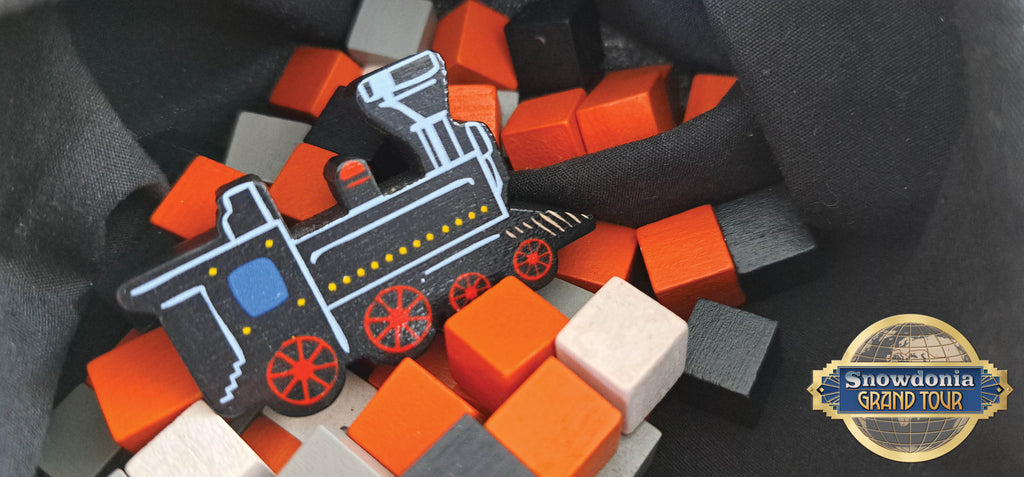Gaining various colours of cubes is one of the most iconic images in eurogames. Agricola, Brass, Caylus, Terraforming Mars, Terra Mystica, Lords of Waterdeep… the list of well known eurogames featuring the collecting, moving, spending and exchanging of cubes is vast. Snowdonia is part of this same tradition. On a surface level, Snowdonia’s implementation of cubes may seem simple. Look closer though, and it reveals unspoken depths that, when understood, can really give you an edge. So, let’s reach into the bag and see what secrets lay within.
What are the cubes in Snowdonia and what are they for?
By default, a game of Snowdonia will contain 5 types of cube:
Iron ore – Used to make steel bars which in turn can be laid as track or used to build stations and trains.
Stone – Used to build stations.
Coal – Used to gain your 3rd worker from the pub via a train card.
Events – Players cannot obtain these. They instead trigger events, which move the game forward in various ways.
Rubble – Needs to be excavated so track and stations can be built. Can be used to make stone or score contract cards.
Today though, we’ll only be looking at the first 4 of these. Rubble is a bit different from the rest as it never enters the bag and is tied to excavation rather than the stockyard. We also explored rubble in some detail in the previous train of thought article.
How do I get these cubes?
The main way to gain cubes in Snowdonia is with the stockyard action. Placing a worker there will let you take 3 cubes of your choice from those available (with a limit of 1 coal per worker).
The stock yard is a limited supply. It starts play with 7 iron ore, 4 stone and 1 coal. At the end of each round, more cubes are added to the supply randomly from the bag (the quantity is either 6, 9 or 12 based on player count). The composition of the bag is also not even. Iron ore is the most frequent resource, followed by stone, then coal and finally events.
Which resources should I take?
This is almost entirely dependent on your goals. Here are some basic goals you might have and how they’d guide your play:
Build an early train – Take as much coal as possible alongside enough iron ore for the train you want.
Score a high point rail-based contract card – Get 9 iron ore to efficiently convert at the works.
Capitalise on opportunities on an upcoming station card – Collect stone.
None of these scenarios are tremendously nuanced in isolation, but they can change significantly when brought into contact with your opponent’s plans. Snowdonia as a game rarely makes you “commit” to a particular archetype of play. Your contracts or train will often push you in a certain direction, but you’re never completely locked in. This is interesting because it means players can pivot and dip into any aspect of the game as it progresses. Scarcity often drives such decisions.
Let’s use an example of a player who has been consistently taking iron ore and laying track to try to score a contract that requires them to lay 5 rails. They’ve laid 3 rails and have 2 more to go, but they notice there is only 3 stone left in the supply. Although this would deviate from their plan to finish the rails, 3 stone is very easy to leverage into a building for 6 or 7 points. By taking it, they’re securing a solid scoring opportunity for themselves later and denying anyone else from having stone this round.
Alright, I understand those cubes then, this seems fairly simple. What about events?
Events can be a source of major disruption in a game of Snowdonia. It is quite common to see new players shocked or upset as the game lurches and digs up 4 spaces worth of rubble, shuts a station they were planning to build in or lays the game-ending track before they could.
It makes sense, that does sound pretty random.
It is random to an extent, but often such upsets are more predictable than first meet the eye. This is because the bag is not completely random. In fact, its entire contents can be deduced at any time by looking at where the other cubes on the table are. If the stock yard is overflowing or players are hoarding, this means there are fewer cubes in the bag and thus the probability of events is higher.
I’m unconvinced, show me some examples.
Let’s take a 3 player game as an example. Assuming 6 of the 14 coal in the box is placed on trains during set-up, the bag starts with 20 iron ore, 11 stone, 8 coal and 5 events. 44 cubes total. Using a hypergeometric distribution probability calculator, this means there is a 54% chance of drawing 1 or more event cubes from the bag but only a 13% chance of drawing 2 or more. From this you can see you would actually expect to see an event on turn 1 slightly more often than not.
Now however, let’s look at an example later in the game. Players have been hoarding resources and the bag is down to only 17 cubes of which 4 are events. You are now looking at an 86% chance of drawing at least 1 event and a 44.5% chance of drawing 2 or more. These are pretty radically different odds to be making your decisions on.
Let’s use the above odds to explore a mistake a new player could make. The new player has have 6 iron ore and wants to do the following so they can lay rail next turn:
Worker 1: A – Gain 3 more iron ore
Worker 2: C – Convert 9 iron ore into 3 steel bars
Worker 2: D – Lay track
This is a less efficient conversion, but it will score them the track they were otherwise very likely to miss if they’d gone with the original plan.
This is relevant to other resources in the bag too. If a player's plan revolves around stone but they can deduce there’s not much stone in the bag and stockyard then it may be time to change plans for a bit.
So I’m supposed to stop the game to crack out a hypergeometric distribution probability calculator?
Of course not, it just isn’t practical to be counting the number of cubes constantly, nor is it reasonable to expect players to be using an advanced calculator mid-game. But, these examples hopefully illustrate how you could still make better judgements just by making estimates based on quick scans of the cubes on the table.
The relationship between resource cubes and the bag in Snowdonia is a rich one that permeates much of the game. It's an interesting comparison point when considering other games. In Lords of Waterdeep for example, cubes are taken and returned to a supply. They are simply resources with no further dynamic interest. Brass, however takes a different but interesting approach where cubes are not random but form a dynamically priced market.
This was a crunchier topic to chew on, but this sort of probability analysis is a skill that will serve you well in almost any board game! Can you recall a time you were caught out by an event cube? Do you feel better equipped to handle that situation next time? Let me know in the comments!
Also, now we’re 3 articles in, I’d be curious to hear what you think of these, are they too detailed? Not detailed enough? Again, please leave a comment!
If you’d like to receive all the latest Snowdonia: Grand Tour news before anyone else, sign up to the mailing list here.
If you’re interested in playtesting Grand Tour and are able to make “print and plays”, you can sign up to our playtest mailing list here.
Jaya Baldwin

Leave a comment